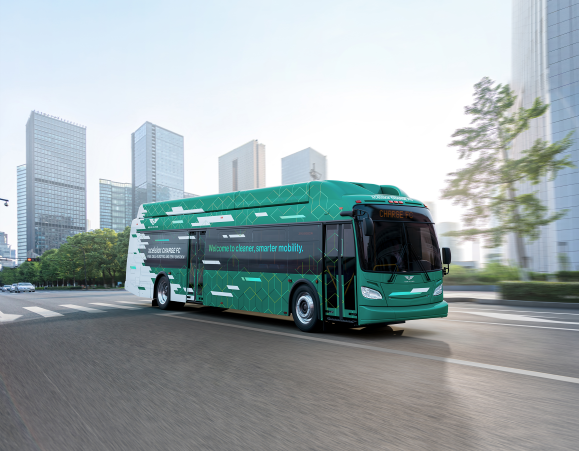
Photo: nfi-group bus
Buses to provide back-up building power in Oakland
13 October 2022
by Christopher Carey
The California Energy Commission (CEC) is funding a vehicle-to-building (V2B) resilience hub to analyse how zero-emission buses can act as mobile back-up power sources for community centres in emergencies.
The project will make use of stored energy from electric and hydrogen buses – owned and operated by Oakland’s AC Transit – to provide filtered air-conditioning at the West Oakland Branch of the Oakland Public Library in the event of unhealthy heat or smoke conditions.
CEC’s Electric Programme Investment Charge awarded the project US$3.2 million, with a combined US$400,000 in matching funds from the West Oakland Environmental Indicators Project (WOEIP) and AC Transit.
“Initiating the first community resilience hub powered by a bidirectional V2B charging system has been an incredible journey,” said Jason Hanlin, Director of Technology Research at CTE.
“By bringing together leading edge technological innovation and sustainability, we are able to offer much-needed emergency response benefits for both transit agencies and communities.
“For a project with so many key players, we are excited to apply CTE’s proven project management approach to usher this novel project from concept to fruition.”
V2B Oakland
The pilot, dubbed V2B Oakland, involves a project team comprising the Centre for Transportation and the Environment (CTE), the Mobility House, AC Transit, New Flyer, Schneider Electric, City of Oakland and WOEIP.
Each battery electric bus (BEB) will contribute six hours of back-up power to the critical loads at the library, and each hydrogen fuel cell-electric bus (FCEB) will provide up to 11 continuous hours of back-up power.
This will reportedly displace nearly 45 kilogrammes of carbon emissions per hour compared to traditional diesel back-up generators.
Working in close coordination with bus manufacturer New Flyer of America, a subsidiary of NFI Group, the project also marks the first time a US transit agency will have the capability to use a hydrogen vehicle for V2B back-up power.
“We are thrilled to bring our vehicle-to-everything expertise from numerous projects in Europe and Asia to now develop the first ever vehicle-to-building resilience hub in the US,” said Gregor Hintler, Managing Director, Mobility House.
“Our ChargePilot system ensures all transit mobility needs are met and orchestrates the charge and discharge of the bidirectional chargers so that the buses can power critical building loads.”
The project is expected to be in place by the middle of next year and pilot activities will continue until July 2025.
Image: nfi-group bus







